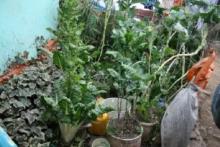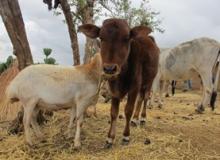Results
Having a vegetable gardens at the homestead can help improve nutrition, while surplus may be an important source of income. Greywater is a valuable source of water in (semi) arid areas and helps reduce pollution of the compound.
The case study Greywater reuse interventions: keyhole and vertical gardens compares two practices of household gardening in which vegetables are watered using greywater (household wastewater from kitchen and washing).
- A keyhole garden is a waist height garden bed surrounded by rocks and stones, with a walkway (‘keyhole’) to allow easy access. The bed is comprised of layers of various organic materials that add nutrients and retain moisture.
- A vertical garden is made from a bag or other vessel, filled with a mixture of soil, ash and compost. Leafy greens are cultivated in holes, cut in the side of the bag, and on top. Some designs include a gravel column at the centre of the bag to allow filtration of greywater.
The case study is part of the MUStRAIN case study series in which the uptake of Multiple Use Services (MUS) in different contexts within Ethiopia is being documented. The case studies analyse cost-benefit relations as well as opportunities and challenges for implementation of MUS.
The case study Manual well drilling: an alternative for shallow groundwater development for multiple use services (MUS) looks into the features of manual well drilling in Ethiopia and the costs and benefits. Manual drilling is a fast and relatively low-cost method of accessing shallow groundwater for multiple uses.
There is a large variation in cost between the enterprise or organisations involved, and diameter. Manual drilling is normally cheaper than hand digging. Reasons are due to time taken and the lower cost of lining.
Initially, promotion and distribution of manually drilled wells was set up for irrigation, but in practice people use these wells for various purposes, as they are convenient. The smaller diameter well and its covering slab prevent inflow from dirty surface water.
The case study is part of the MUStRAIN case study series in which the uptake of Multiple Use Services (MUS) in different contexts within Ethiopia is being documented. The case studies analyse cost-benefit relations as well as opportunities and challenges for implementation of MUS.
Livestock watering is one of the most widespread productive uses of water in multi-purpose water supply systems in Ethiopia. At the same time, livestock may increase degradation of grazing lands threatening water resources.
The impacts of improved water supply on livestock productivity may be high, and combined with watershed management measures that restrict free grazing, livestock management practices may be strongly affected.
The case study is part of the MUStRAIN case study series in which the uptake of Multiple Use Services (MUS) in different contexts within Ethiopia is being documented. The case studies analyse cost-benefit relations as well as opportunities and challenges for implementation of MUS.
This research report, by BNP, seeks to assess the possibilities and limitations of using RWH for drinking water, biogas and irrigation and identity the possibilities and limitations of combining these different uses. Specifically, it seeks to:
- Assess the water use practices and water needs with respect to different purposes in rural households presently challenged with water scarcity to identify the need for rainwater harvesting for MUS
- Identify the effectiveness of combining roof water harvesting systems with surface runoff systems for MUS
- Analyse financial and economic aspects and impacts of MUS from rainwater harvesting systems
- Test the combination of Ferro-cement tanks with “1 bag cement” systems and plastic ponds
Zambia has invested substantially in rural water supply since the early 1970s, but the actual number of people effectively provided with safe drinking water remains very low. It is estimated that only 37% of the population had access to safe water supply in 2000, a deprivation that has characterised and entrenched poverty in Zambia’s rural areas. Attempts to alleviate this poverty require a policy that favours a shift in emphasis from provision of safe water supplies to that encompassing productive water. The latter enables families to increase income and reduce costs of healthcare services for water-related illnesses. Gains in income generation will further enable communities to take care of their safe water needs, addressing the systematic challenge of sustainability in the delivery of rural water supply programmes. Under such favourable conditions rural communities can enjoy a life of quality and dignity.
Both water and sanitation and food are recognised as human rights, that every citizen is entitled to enjoy. Our professions, governments and agencies work diligently, but mostly separately on these two issues. In some places, such a clear separation of efforts is not always possible or sensible though. Water and food are especially closely linked in rural and peri-urban areas in low income countries, and here, efforts to improve access to water and food security demand integrated components that build on the potential synergies. Families integrate their own efforts after all, and many traditional water supplies schemes cater for multiple uses. To maximize the developmental impact of their work, this is something that professionals and organisations need to get better at too. This article highlights one the productive use of domestic water supplies where such a coordinated approach is required, and illustrates it by case studies from Ethiopia.
Multiple-use water services is a holistic approach to sustainable water services that improves health and livelihoods. This holistic, participatory approach to water improves livelihoods and health, increases sustainability, and ultimately improves people’s lives overall. By investing a little more to address people’s multiple needs, impact is maximized in the long term. [authors abstract]
Multiple-use water services is a holistic approach to sustainable water services that improves health and livelihoods. This holistic, participatory approach to water improves livelihoods and health, increases sustainability, and ultimately improves people’s lives overall. By investing a little more to address people’s multiple needs, impact is maximized in the long term. [authors abstract]
In collaboration with IDEO.org, Winrock International created a stylized how-to guide that shows implementers, funders, and policymakers: what MUS is, how it looks in practice, and how to incorporate MUS into their own operations.
This report synthesizes the results of a scoping study into MUS in five countries: Ethiopia, Ghana, Tanzania, India and Nepal. It analyses the potential for a MUS approach for four different entry points for scaling pathways: domestic-plus, irrigation-plus, self-supply and community-based MUS, for each of the five countries. It then identifies a number of common barriers across the countries and potential manners of overcoming those.



